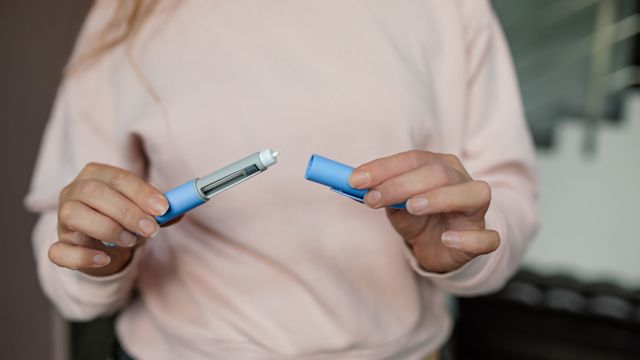Injectable semaglutide medications like Ozempic and Wegovy have revamped the treatment landscape for people with diabetes and obesity. But what are these medications, exactly, and how can they improve your health? Is there even a difference between Ozempic and Wegovy? Let’s review the basics of these buzzworthy drugs.
What is semaglutide?
Semaglutide is the active ingredient in Ozempic and Wegovy. It’s in a class of medication called glucagon-like peptide-1 receptor agonists, or GLP-1s, for short. GLP-1s work by imitating the function of the GLP-1 hormone, which is naturally produced by your body after eating. This important hormone:
- Promotes insulin production, which can help lower blood sugar (blood glucose) and control type 2 diabetes
- Allows your body to digest food more slowly
- Helps you eat less and feel full faster by subduing hunger cues in the brain
Ads touting the weight loss benefits of semaglutide have infiltrated our phones and televisions, but this treatment isn’t new. Healthcare providers (HCPs) have been using semaglutide to treat type 2 diabetes since 2005. GLP-1s have only recently been recognized as a mainstream weight loss tool.
Are there long-term studies on semaglutide?
Semaglutide is a focus of many long-term research initiatives. One such initiative, published in Nature Medicine in 2024, examined the effectiveness of semaglutide in nondiabetic participants with overweight or obesity and known cardiovascular disease. The analysis found that semaglutide was associated with significant weight loss that was sustained over four years, as well as a reduction in serious cardiovascular events such as heart attack and stroke.
Additional research, published in the American Journal of Cardiology in 2024, evaluated nondiabetic participants with overweight or obesity. The review found that 33.4 percent of study participants who received semaglutide achieved weight loss of more than 20 percent over two years, compared to just 2.2 percent of participants who received a placebo. A reduction in blood pressure and waist circumference was also seen. An increase in gastrointestinal side effects (such as abdominal pain, diarrhea, and constipation) was noted, but most events were temporary and mild or moderate in severity.
Other research initiatives show similar outcomes among people with type 2 diabetes, including significant weight loss and improved blood sugar with a low risk of hypoglycemia (more on semaglutide side effects below).
Key differences between Ozempic and Wegovy
Ozempic and Wegovy are name brands of the same drug (semaglutide) at different strengths. Both drugs are manufactured by pharmaceutical company Novo Nordisk. While these medications share many similarities, there are a few key differences to consider before deciding which one may be right for you.
Indications for use
Ozempic is approved by the U.S. Food and Drug Administration (FDA) to treat type 2 diabetes in adults. It can lower blood sugar levels when used in combination with diet and exercise.
Ozempic also reduces the risk of major cardiovascular events in adults with type 2 diabetes and known heart disease. Though not approved as a weight loss drug, Ozempic often results in weight loss. It may be prescribed “off-label” (for a use unapproved by the FDA) to people who want to lose excess body fat.
Wegovy, on the other hand, is approved by the FDA to treat obesity. It can be used in conjunction with diet and exercise to:
- Treat obesity in children and adults ages 12 and older
- Promote weight loss in adults with overweight and a weight-related medical issue (such as high blood pressure, diabetes, or high cholesterol)
- Lower the risk of major cardiovascular events in adults with known heart disease and obesity or overweight
Administration and dosage
Both Wegovy and Ozempic come in the form of a prefilled, single-use pen that’s injected once weekly, on the same day every week, into the abdomen, thigh, or upper arm. Both medications can be injected with or without food and are available in a range of doses.
Your ideal dosage will depend on why you’re taking the drug, your health, and your treatment goals. Many people begin Ozempic or Wegovy at a weekly dose of 0.25 milligrams (mg), then gradually increase their dosage over the course of several months. Wegovy has a higher maximum dose (2.4 mg) than Ozempic (2 mg).
An oral form of semaglutide called Rybelsus is also approved by the FDA to treat type 2 diabetes. This is a tablet that’s swallowed every morning at least 30 minutes before eating and taking other oral medications.
Which is better for weight loss, Ozempic or Wegovy?
There’s no question that Ozempic and Wegovy can jumpstart weight loss, but is one better than the other? Because Wegovy is FDA-approved as a treatment for obesity (whereas Ozempic is not), many HCPs recommend Wegovy over Ozempic. However, HCPs can and do prescribe Ozempic off-label for weight loss and weight management purposes.
Keep in mind that no semaglutide, GLP-1, or drug of any sort is a cure-all for diabetes or obesity. Both issues are chronic (long-term) conditions that require a lifetime of sensible diet choices and regular physical activity. Semaglutide does not replace a healthy lifestyle—in fact, Wegovy and Ozempic must be combined with diet and exercise to be effective.
Moreover, research shows that people who stop taking Ozempic and Wegovy tend to gain the weight back. A 2022 study published in Diabetes, Obesity and Metabolism found that participants regained two-thirds of the weight they lost one year after discontinuing weekly semaglutide. Key health indicators such as blood pressure, cholesterol, and blood sugar levels also returned to pre-treatment levels.
If you’re considering using Ozempic or Wegovy to help you achieve your weight loss goals, speak with your HCP about what other steps you can take to manage your weight. They can provide diet and exercise recommendations based on your health profile and preferences.
What are the CDC’s diet and exercise guidelines?
The Centers for Disease Control and Prevention (CDC) advises most adults to get 150 minutes of moderate-intensity physical activity every week. (That’s around 30 minutes per day, five days per week.) This can include simple activities like taking a brisk walk, doing water aerobics, or riding a bike. The CDC also encourages muscle-strengthening activities (such as lifting light weights or doing body weight exercises) at least twice a week.
The CDC defines a healthy eating plan as one that:
- Includes a variety of protein-rich foods, such as lean meats and poultry, nuts, seeds, legumes, and eggs
- Emphasizes vegetables, fruits, whole grains, and low-fat or fat-free dairy products
- Limits saturated fats, trans fats, cholesterol, added sugars, and sodium (salt)
- Doesn’t exceed daily calorie needs
Your HCP can provide you with additional information about what exercise and healthy eating plans are best for you.
What are the possible side effects of Ozempic and Wegovy?
All drugs have the potential for side effects, including Ozempic and Wegovy. These medications share several possible side effects and treatment precautions, as noted on the product websites.
Ozempic side effects
The most common side effects of Ozempic include:
- Nausea or vomiting
- Abdominal pain
- Diarrhea
- Constipation
Serious but less common side effects of Ozempic include:
- Pancreatitis (inflammation of the pancreas)
- Worsening kidney disease or kidney failure
- Gallstones and other gallbladder problems
- Changes in vision in people with type 2 diabetes
- Increased risk of liquid or food entering the lungs during procedures that use anesthesia or deep sedation
- Low blood sugar (hypoglycemia) in people who take other medicines that may lower blood sugar, such as insulin or sulfonylurea
- Serious allergic reactions
Wegovy side effects
Wegovy can be prescribed at a larger dose than Ozempic and has the potential to cause additional side effects. Common side effects of Wegovy include:
- Nausea or vomiting
- Abdominal pain
- Diarrhea
- Constipation
- Fatigue
- Headache
- Dizziness
- Bloating
- Heartburn
- Sore throat or runny nose
- Gas
- Stomach flu
- Hypoglycemia in people with type 2 diabetes or who take insulin or sulfonylurea
Like Ozempic, Wegovy may cause serious side effects. These can include:
- Pancreatitis
- Worsening kidney disease or kidney failure
- Gallbladder problems, including gallstones
- Vision changes in people with type 2 diabetes
- Increased risk of liquid or food entering the lungs during procedures that use anesthesia or deep sedation
- Serious allergic reactions
- Rapid heart rate
- Sudden changes in mood, thoughts, feelings, or behavior, including worsening depression or thoughts of suicide
Other Ozempic and Wegovy precautions
Ozempic and Wegovy may increase the risk of benign (noncancerous) thyroid tumors or thyroid cancer. Inform your HCP right away if you develop shortness of breath, a lump or swelling in your throat, voice hoarseness, or difficulty swallowing.
You should not use Ozempic or Wegovy if you:
- Have multiple endocrine neoplasia syndrome type 2 (MEN 2)
- Have a personal or family history of medullary thyroid cancer
- Are allergic to semaglutide or other ingredients found in Ozempic or Wegovy
Before starting Ozempic or Wegovy, let your HCP know if you:
- Are pregnant or plan on becoming pregnant (semaglutide should be discontinued at least two months before pregnancy)
- Are breastfeeding (researchers are unsure if these drugs pass into breastmilk)
- Have a previous or current kidney or pancreas condition
- Have a history of diabetic neuropathy
- Plan on having surgery that will require anesthesia or deep sedation
Let your HCP know if you have a history of mental health concerns such as depression or suicidal thoughts before taking semaglutide. Also, inform your HCP of any previous or current medical conditions and medications you may be taking. This includes prescription and over-the-counter (OTC) drugs, vitamins, and herbal supplements.
Wegovy and Ozempic should not be used at the same time or in combination with other GLP-1 drugs.
When to call 911
Call 911 immediately or seek emergency medical care if you or someone around you experiences severe abdominal pain or signs of a serious allergic reaction. This may include:
- Trouble breathing or swallowing
- Very rapid heartbeat
- Faintness
- Severe rash
- Swelling of the tongue, throat, lips, or face
Stop taking Ozempic or Wegovy if any of these symptoms occur.
If you or someone you know is coping with severe anxiety, depression, or thoughts of suicide, text or call 988 to reach the 988 Lifeline. You can also chat with a counselor online. This service is free, confidential, and available 24/7.
The bottom line on Ozempic and Wegovy
Ozempic and Wegovy are semaglutide medications that come in varying doses and are approved by the FDA to treat different conditions. Ozempic is used to treat type 2 diabetes, while Wegovy is a weight loss drug. Both medications can promote significant weight loss and reduce the risk of serious health problems like heart attack and stroke. The most common side effects of Ozempic and Wegovy include nausea, vomiting, abdominal pain, diarrhea, and constipation.
Speak with your HCP to learn more about the potential benefits and risks of Ozempic and Wegovy and learn which may be right for you.







